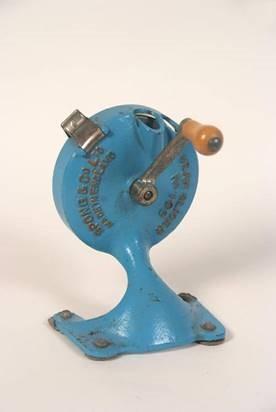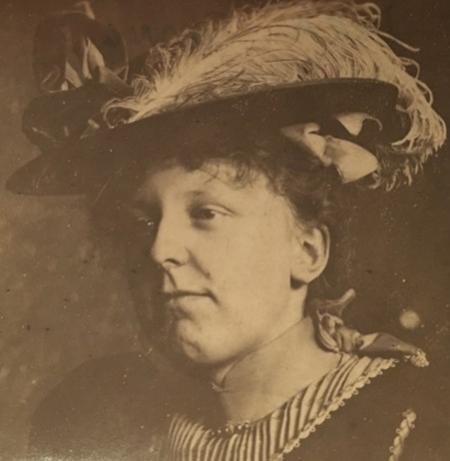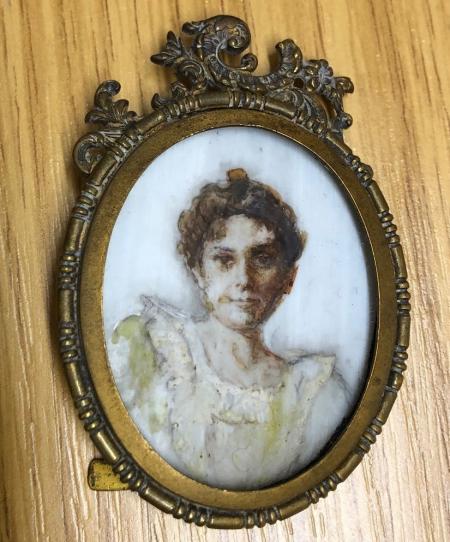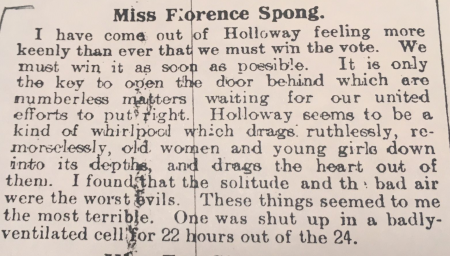Here’s our gadget that may, or may not, be familiar. Can you guess what it is?

It's a bean slicer! This is how it works. Did your family have one?
This bean slicer along with food mincers, knife grinders, coffee grinders, trivets and many, many other gadgets besides were all made by Spong & Co Ltd, operating from 1856 and founded by James Osborn Spong when he was only 16 years old. Spong & Co later had a factory in South Tottenham at Woodville Grove from 1925. The son of James Osborn (also called James) had moved to Tottenham in 1923 to Braemar Road. Up until then, the main base was in Holborn. Spong & Co’s business went from strength to strength. The unusual name was one to remember, an Ad maker’s dream (‘You can’t go wrong with a Spong’ said the adverts in the 1950s), making it a brand name still known to many people today.
James Osborn Spong (1839 - 1925) - was a prolific inventor. He patented and manufactured the famous Spong food mincer and bean slicer. The range of Spong labour-saving gadgets and utensils graced many Victorian and Edwardian households, with more and more gadgets coming onto the market (well into the 20th century), including a ‘Portable Shampoo’ in 1890 – a forerunner of the shower! Spong revolutionised the domestic economy amongst the emerging middle-class families, who were unable to afford numerous household servants like the upper classes. All household chores, often in the kitchen – and mostly carried out by women - were laborious, time-consuming and done by hand. A Spong device became an obligatory piece of kitchenware until the development of electrical equipment. You can read the history of the company, with its long list of gadgets and equipment here.
The Spong family lived in Princes Avenue in Muswell Hill from 1906 to 1909.
James and his wife Frances had seven children, including five daughters - Minnie Frances, Annea, Florence, Dora and Irene. They enjoyed a progressive liberal upbringing and education. From a comfortably well-off family, they each earnt their own living. Minnie Frances was a teacher, Annea a portrait artist of some repute, Florence was a weaver, “artistic dress maker” and lace-maker, Dora trained as a sanitary inspector and midwife in Tottenham, and Irene became a soprano singer.
The Spong fortunes soared with the highly successful sales of the Spong meat mincer and – later - a sausage-making machine. The story passed down the family suggests this surge in sales happened to coincide with the conversion of all the Spong women to vegetarianism, pacifism and their joining of the Women’s Social and Political Union (WSPU) in 1908. The Spong family divided their household in two – those meat-eating or those vegetarian – with the women grinding nuts in their own Spong mincer.
Unfortunately, James Spong had affectionately named a range of Spong meat mincers ‘The Minnie’, after his eldest daughter. On becoming a vegetarian, the principled Minnie announced she preferred to be known as Frances from then on.
The Spong Sisters
Joining the WSPU in 1908 to fight for the vote, the Spong sisters were a remarkable group of women. All the Spong women attended WSPU demonstrations. Three sisters were imprisoned in Holloway for their activism – Dora, Florence and Irene. Their names are recorded on The Roll of Honour of Suffragette Prisoners 1905-1914 in The National Archives. In the 1911 Census, with the exception of Annea, none of the women’s names are recorded. Like other women around the country, and in our local area, this was a silent protest for the votes for women campaign.
Dora Spong (1879-1969)
Dora Spong was arrested a total of five times. She was the first of the sisters to be jailed for obstruction in June 1908. Whilst Dora was in prison, Annea’s portrait of Dora was hanging on the walls of the Royal Academy! A dedication on 18 June 1908 was published for Dora:
“The Finsbury Branch of the Independent Labour Party have written to Miss Dora Spong, … and now a prisoner in Holloway, to express their admiration of the courage and determination displayed in submitting to the onus of the prison cell in the women’s cause. They send hearty greetings across the prison wall.”
Following other arrests, Dora was imprisoned a second time (under the name of Mrs Dora Beedham this time - two years earlier she had married Ralph Beedham, an engraver, sympathetic to all the same ideals). Her sentence was two months with hard labour after taking part in the WSPU window-smashing campaign in March 1912. Dora’s WSPU certificate signed by Emmeline Pankhurst survives, lovingly restored by her family, commemorating Dora’s dedication to the cause “ever ready to obey the call of duty”.

Dora was a sanitary inspector and midwife in Tottenham, c.1905 - 1910. Image Courtesy and © The Spong family.
Frances, Irene and Annea
Frances (Minnie, 1869 -1954), was a committed vegetarian and fruit and vegetable grower, growing enough to support the Spong food consumption as well as supplying an open-air vegetable market. Although Frances was also involved in the women’s Suffragette movement she was not as active as her other sisters. Like her sisters, Irene (1882-1960) served time in Holloway Prison. Outside prison, she gave concerts supporting the campaign, and advertised in the Votes for Women as a singing teacher. It is said fledgling WSPU speakers could learn from Irene how to project their voices over a restless audience. Annea (1870-1957), was an accomplished artist, like numerous WSPU campaigners. But it was whilst taking dancing classes with Isadora Duncan’s brother, that she became a ‘physical culture’ expert. Her exercises, designed to benefit body and mind, were performed and shared, accompanied musically by Irene. Annea later started the Spong Rhythmic Dancing, later known as Natural Movement Dancing.

One of the Spong sisters. Image courtesy and © The Spong family.
Florence Spong (1873-1944)
Dora and Florence were the most militant of the sisters. Charged with stonethrowing at the WSPU deputation of 29 June 1909, Florence was sentenced to a month’s imprisonment. She went on hunger strike. Forcibly fed in prison, we can only imagine the horrific conditions and terrible pain and suffering from this dangerous procedure. This did not stop Florence protesting again at how suffragettes were treated, in Parliament Square on ‘Black Friday’, November 1910. This got her another two months’ imprisonment. Whilst in Holloway, Florence embroidered her signature on the WSPU banner made by fellow prisoners (you can see the banner in this online article here).
A delightful miniature portrait painting by Annea of Florence survives. The family story handed down says whilst sitting for a portrait painted by Annea, Vezey Strong (an Alderman of the City of London) fell in love with Florence. They became engaged. But the romance ended abruptly because Vezey was the magistrate that Florence was called to appear before, following her arrest.


Portrait of Florence by her sister Annea, along with a news-clipping showing what Florence had said on her release from Holloway. Images courtesy and © The Spong family.
Florence never married. Two of her sisters were also unmarried. By the 1918 Representation of the People Act – which gave only ‘women of property over the age of 30’ the right to vote – James Spong ensured his three unmarried suffragette daughters were property owners. Not many families could have done this of course. For these women at least, they could now comply with the new regulations, allowing them to vote for the first time.
We are very grateful to the Spong family in Muswell Hill for coming forward with their extraordinary story in 2018 about these amazing women in their family.